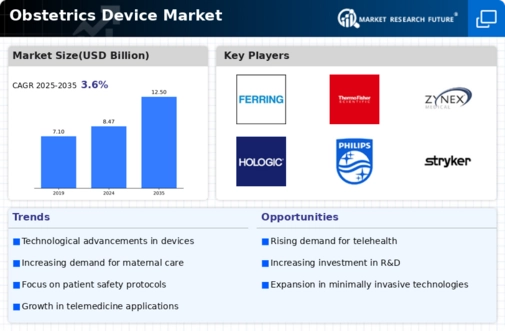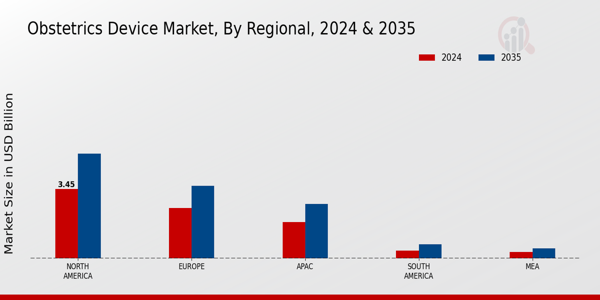Rising Birth Rates
The obstetrics device market appears to be influenced by rising birth rates in various regions. Increased fertility rates, particularly in developing nations, contribute to a higher demand for obstetrics devices. According to recent statistics, certain areas have reported birth rates exceeding 20 births per 1,000 people. This trend necessitates the expansion of healthcare facilities and the procurement of advanced obstetrics devices to ensure safe deliveries. As healthcare providers strive to accommodate the growing number of expectant mothers, the obstetrics device market is likely to experience substantial growth. Furthermore, the increasing awareness of maternal health and the importance of prenatal care may further drive the demand for innovative obstetrics devices, thereby enhancing the overall market landscape.
Technological Innovations
Technological innovations play a pivotal role in shaping the obstetrics device market. The advent of advanced imaging technologies, such as 3D ultrasound and fetal monitoring systems, has revolutionized prenatal care. These innovations not only enhance diagnostic accuracy but also improve patient outcomes. The market for obstetrics devices is projected to grow at a compound annual growth rate of approximately 8% over the next few years, driven by the integration of artificial intelligence and telemedicine solutions. Such advancements enable healthcare providers to monitor pregnancies more effectively and provide timely interventions. As technology continues to evolve, the obstetrics device market is expected to witness a surge in demand for state-of-the-art devices that facilitate better maternal and fetal health management.
Regulatory Support and Standards
Regulatory support and the establishment of standards are crucial drivers for the obstetrics device market. Governments and health organizations are increasingly implementing regulations that ensure the safety and efficacy of obstetrics devices. This regulatory framework not only fosters consumer confidence but also encourages manufacturers to innovate and improve their products. Compliance with these regulations often leads to the development of higher-quality devices that meet the needs of healthcare providers and patients alike. As the industry adapts to these standards, the obstetrics device market is expected to grow, with manufacturers focusing on creating devices that align with regulatory requirements. This dynamic environment suggests that regulatory support will continue to play a vital role in shaping the future of the obstetrics device market.
Growing Awareness of Maternal Health
The growing awareness of maternal health issues significantly impacts the obstetrics device market. Educational campaigns and initiatives aimed at promoting maternal health have led to increased demand for prenatal care and monitoring devices. As more women become informed about the importance of regular check-ups and screenings during pregnancy, the need for advanced obstetrics devices rises. Reports indicate that regions with heightened awareness have seen a marked increase in the utilization of obstetrics devices, such as fetal monitors and ultrasound machines. This trend suggests that as awareness continues to grow, the obstetrics device market will likely expand, driven by the need for innovative solutions that cater to the evolving needs of expectant mothers.
Increased Investment in Healthcare Infrastructure
Investment in healthcare infrastructure is a significant driver for the obstetrics device market. Governments and private entities are increasingly allocating funds to enhance maternal healthcare services. This trend is particularly evident in regions where maternal mortality rates remain high. For instance, investments in hospitals and clinics are aimed at improving access to quality obstetric care. The World Health Organization has emphasized the need for better healthcare facilities, which has led to a surge in the procurement of obstetrics devices. As healthcare systems expand and modernize, the demand for advanced obstetrics devices is likely to rise, thereby propelling the market forward. This investment not only supports the growth of the obstetrics device market but also aims to improve maternal health outcomes on a broader scale.























Leave a Comment